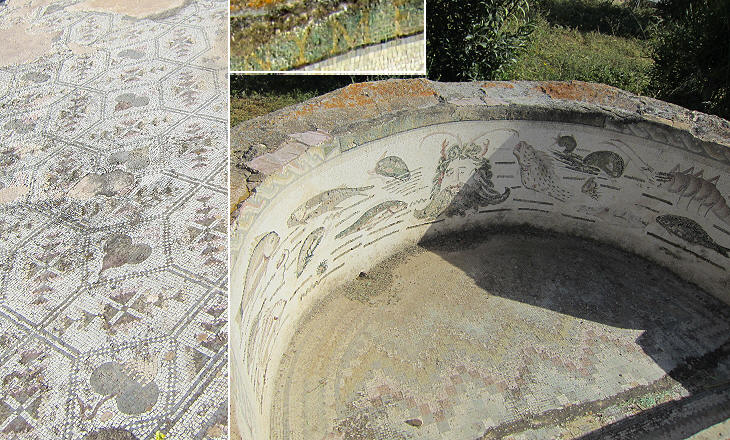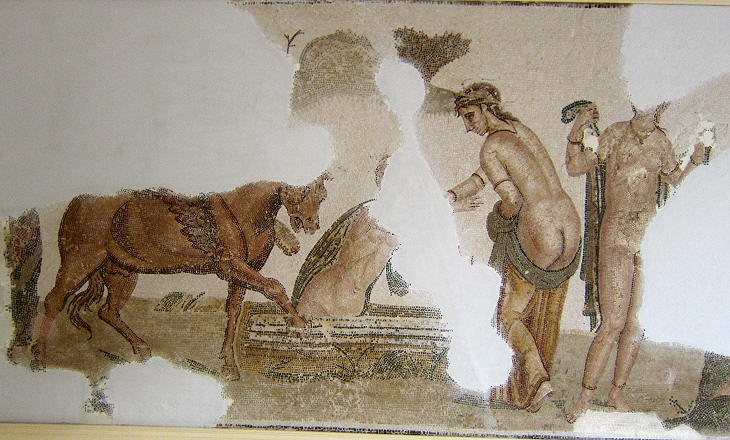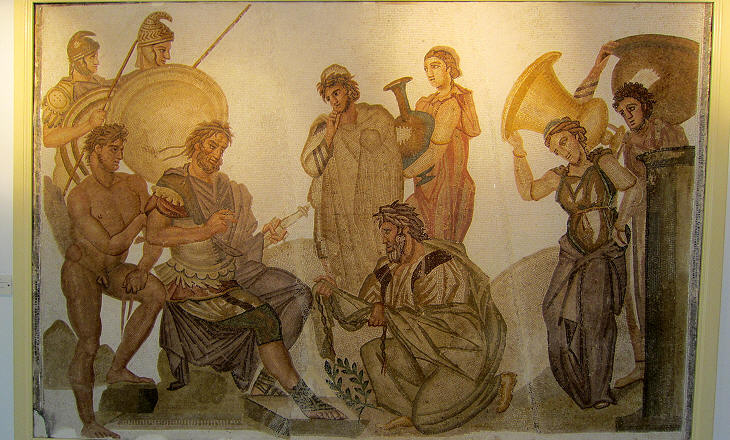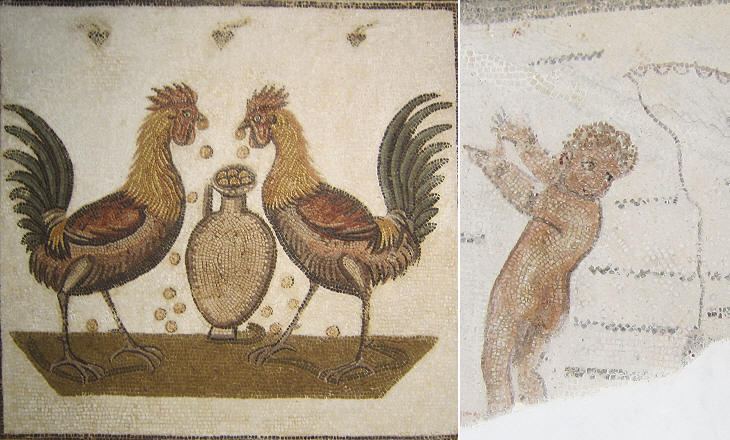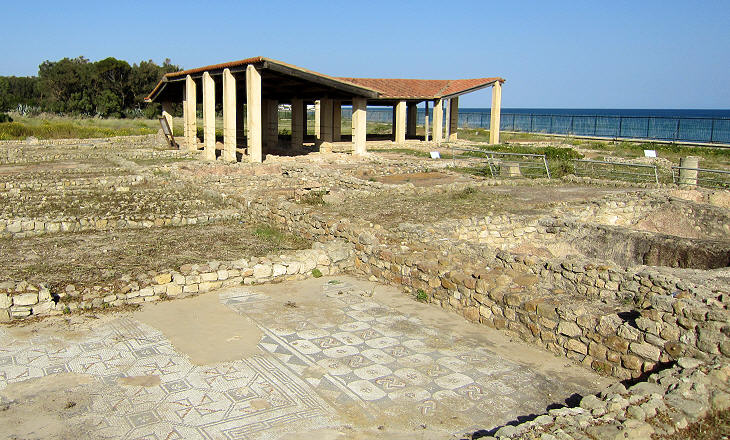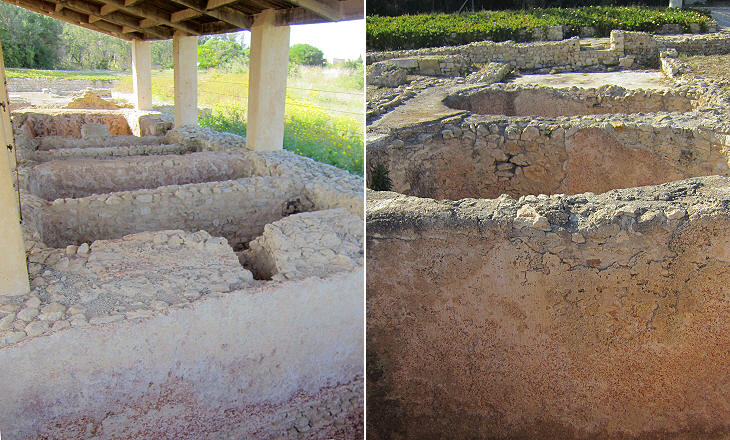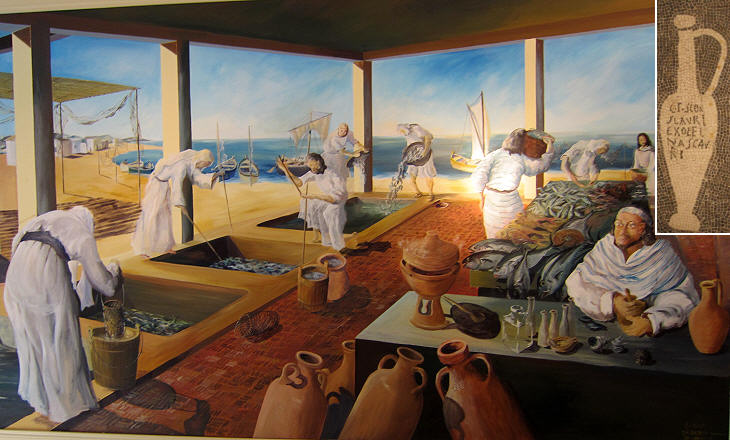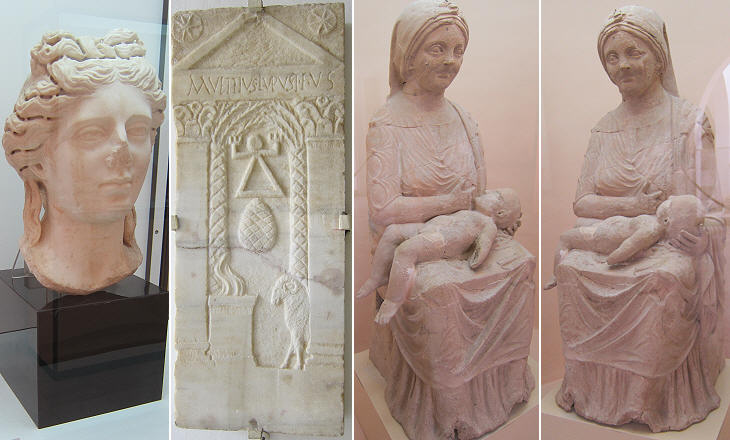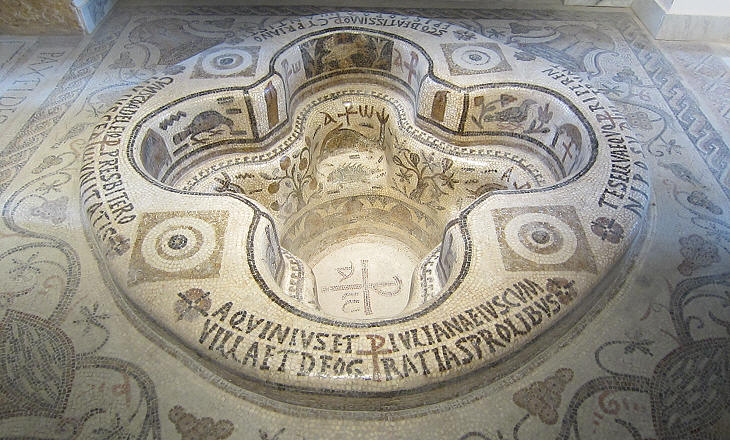  What's New! Detailed Sitemap All images © by Roberto Piperno, owner of the domain. Write to romapip@quipo.it. Text edited by Rosamie Moore. Page added in June 2012. |
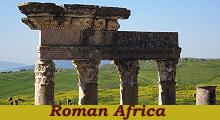 - Neapolis (Nabeul) - Neapolis (Nabeul)(temple at Thugga) Neapolis was founded by the Phoenicians after Carthage and this perhaps explains its Greek name which means New City. Other sources report that it was founded by Greek colonists and that it was conquered by the Carthaginians subsequently. During the Third Punic War, Neapolis sided with Carthage and it must have been punished by the Romans for this, because there are no references to it for a long period. During the war between Pompey and Caesar, Neapolis sided with the latter and it was rewarded with the status of colonia, which granted its citizens a series of rights, including some related to trade. Colonia Julia Neapolis became a prosperous port with its own guild of navicularii (shipowners) (see the mosaic of the Carthaginian navicularii at Ostia). After the Arab conquest it rapidly declined, but its name did not disappear and it currently indicates Nabeul, a town a couple of miles to the east of ancient Neapolis.
The ruins of the ancient town were used as quarries for centuries and they eventually disappeared under the Arab town. In the second half of the XXth century Nabeul and its province which includes Hammamet, a popular sea resort, experienced a hasty and uncontrolled urban development which covered whatever memories of the past were left. Eventually during the construction of yet another holiday village along a beach, the ruins of a Roman house containing some very fine mosaics were found and Tunisian authorities decided to protect the area.
The house is known as Nympharum Domus because of an inscription on a small fountain. The mosaic decorating the fountain portrays Oceanus (with horns made of crab claws) surrounded by sea creatures, including the crustacean which can be seen in the image used as background for this page. The mosaicist made a mistake because crustaceans, which are decapods, have ten legs.
Most of the rooms around the courtyard were paved with large coloured mosaics, some of which have been moved to a small museum in town. They are dated IVth century AD and they show the persistence of subjects related to the Classical World. The mosaic of the Muses bathing in a fountain is a variation on the theme of the Three Graces, which was very popular throughout the whole Roman Empire (see an example at Philippopolis, today's Shahba in Syria). The Muses, similar to the Graces, were portrayed with one of them turning her back to the viewer.
Homer's poems were another source of inspiration for large mosaics. The episode of Chryses pleading for the release of his daughter is described at the very beginning of the Iliad: The wrath sing, goddess, of Peleus' son, Achilles, that destructive wrath which brought countless woes upon the Achaeans, and sent forth to Hades many valiant souls of heroes, and made them themselves spoil for dogs and every bird; thus the plan of Zeus came to fulfillment, from the time when first they parted in strife Atreus' son, king of men, and brilliant Achilles. Who then of the gods was it that brought these two together to contend? The son of Leto and Zeus (Apollo); for he in anger against the king roused throughout the host an evil pestilence, and the people began to perish, because upon the priest Chryses the son of Atreus had wrought dishonour. For he had come to the swift ships of the Achaeans to free his daughter, bearing ransom past counting; and in his hands he held the wreaths of Apollo who strikes from afar, on a staff of gold; and he implored all the Achaeans, but most of all the two sons of Atreus, the marshallers of the people: “Sons of Atreus, and other well-greaved Achaeans, to you may the gods who have homes upon Olympus grant that you sack the city of Priam, and return safe to your homes; but my dear child release to me, and accept the ransom out of reverence for the son of Zeus, Apollo who strikes from afar.” Then all the rest of the Achaeans shouted assent, to reverence the priest and accept the glorious ransom, yet the thing did not please the heart of Agamemnon, son of Atreus, but he sent him away harshly, and laid upon him a stern command: “Let me not find you, old man, by the hollow ships, either tarrying now or coming back later, lest your staff and the wreath of the god not protect you. Her I will not set free. Sooner shall old age come upon her in our house, in Argos, far from her native land, as she walks to and fro before the loom and serves my bed. But go, do not anger me, that you may return the safer.” Translation by A.T. Murray
Some mosaics are less easily interpreted; they probably refer to sayings we do not know any longer, but which were popular at the time because the subject of the cocks dropping gold coins was found in other mosaics near Nabeul. According to J. P. Darmon the cocks are symbols of Himeros, a son of Aphrodite who created sexual desire in those he struck with his arrows. In particular they represented the satisfaction of the desire. The subject of children fishing or otherwise being involved in marine activities was a recurring theme (see a large mosaic at Utica).
Another house with some fine elegant mosaics was found very near the sea. It probably belonged to the owner of an adjoining factory where garum, a fish based sauce, was manufactured and shipped. Amphorae full of powdery remains of garum with fish bones, fragments of vertebrae and tiny heads of small fry were found in the ruins of the factory.
Expirantis adhuc scombri de sanguine primo accipe fastosum, munera cara, garum. "Accept this exquisite sauce made from the first blood of the expiring mackerel; an expensive present." Martial - Epigrams - Book XIII - CII - Bohn translation. Martial is one of many Roman writers who made reference to garum. None of them however gave a clear indication of how it was manufactured and there are conflicting reports about its cost.
Garum was made up of small fish and interiors of large ones which were macerated with herbs. It was shipped to Rome in tall and narrow amphorae. It is likely that because of its strong salty taste it was mixed with olive oil resulting in a sort of vinaigrette. It was served on the table from an urceus, a special pitcher. Spain was famous for its garum. According to Pliny the Elder, Pompeii was a garum manufacturing centre.
During the French Protectorate over Tunisia (1881-1956) most of the works of art found in the country were moved to the Museum of Bardo in Tunis. In the last decades Tunisian authorities have opened a number of local museums such as that of Nabeul to display artefacts closer to the location where they were found. The statue of Nutrix was found at Thinissut, a rural shrine in the province of Nabeul. Breast feeding goddesses were rarely portrayed in classical antiquity, but during the Hellenistic and Roman period their depiction became more frequent. Representations of Isis, the Egyptian goddess, as "Isis lactans" breast feeding two infants, have been found in the whole Mediterranean area. In Italy Mater Matuta was portrayed nursing an infant (see an Etruscan statue at Chianciano - it opens in a separate page). The statue of Nutrix found at Thinissut is impressive because it resembles an Early Renaissance Madonna and Child.
Kelibia is a port situated to the north of Nabeul where archaeologists have unearthed some very interesting mosaics. The left mosaic shows an in-depth knowledge of classical myths as the episode portrayed precedes the best known competition between Apollo and Marsyas as the latter picked up the flutes tossed away by Athena. The right mosaic has puzzled experts because of the contrast between the inscription and the image. Sartor is a Late Latin word for tailor, but the shop shown in the mosaic is that of a sutor, a shoemaker. The mosaic could depict a saying similar to Don't judge the book by its cover (the inscription says tailor, but the man is a shoemaker). The portrayal of the shoemaker however does not tally with the traditional iconography of this artisan, who was highly estimated in Roman society. Based on the pale and miserable aspect of the man, Henri Lavagne, an expert in ancient mosaics, suggested that the inscription and the image might refer to an anecdote about a ghost which was reported by Pliny the Younger in Book 7 Letter 27 to Sura. There was at Athens a large and spacious, but ill reputed and pestilential house. In the dead of the night a noise, resembling the clashing of iron, was frequently heard, which, if you listened more attentively, sounded like the rattling of fetters; at first it seemed at a distance, but approached nearer by degrees; immediately afterward a phantom appeared in the form of an old man, extremely meagre and squalid, with a long beard and bristling hair; rattling the gyves on his feet and hands. The poor inhabitants consequently passed sleepless nights under the most dismal terrors imaginable. (..) The house was at last deserted, as being judged by everybody to be absolutely uninhabitable; so that it was now entirely abandoned to the ghost. However, in hopes that some tenant might be found who was ignorant of this great calamity which attended it, a bill was put up, giving notice that it was either to be let or sold. It happened that Athenodorus the philosopher came to Athens at this time, and reading the bill ascertained the price. The extraordinary cheapness raised his suspicion; nevertheless, when he heard tbe whole story, he was so far from being discouraged, that he was more strongly inclined to hire it, and, in short, actually did so. When it grew towards evening, he ordered a couch to be prepared for him in the forepart of the house, and after calling for a light, together with his pen and tablets, he directed all his people to retire within. But that his mind might not, for want of employment, be open to the vain terrors of imaginary noises and apparitions, he applied himself to writing with all his faculties. The first part of the night passed with usual silence, then began the clanking of iron fetters; however, he neither lifted up his eyes, nor laid down his pen, but closed his ears by concentrating his attention. The noise increased and advanced nearer, till it seemed at the door, and at last in the chamber. He looked round and saw the apparition exactly as it had been described to him: it stood before him, beckoning with the finger. Athenodorus made a sign with his hand that it should wait a little, and bent again to his writing, but the ghost rattling its chains over his head as he wrote, he looked round and saw it beckoning as before. Upon this he immediately took up his lamp and followed it. The ghost slowly stalked along, as if encumbered with its chains; and having turned into the courtyard of the house, suddenly vanished. Athenodorus being thus deserted, marked the spot with a handful of grass and leaves. The next day he went to the magistrates, and advised them to order that spot to be dug up. There they found bones commingled and intertwined with chains; for the body had mouldered away by long lying in the ground, leaving them bare, and corroded by the fetters. The bones were collected, and buried at the public expense; and after the ghost was thus duly laid the house was haunted no more. (translation by J.B. Firth) In this context the words quod disperabas explicitum est would mean that the desperation of the ghost ceased when its cause was understood. The overall purpose of the mosaic was an apotropaic one i.e. to avert bad luck and envy.
In 439 today's Tunisia was invaded by the Vandals. In 533 the Byzantines landed on the coasts of the country and by the following year they conquered it. Kelibia was fortified and it acquired importance because of its location at the northern tip of the country. In the 1950s a very finely decorated Byzantine baptistery was found at the side of a Christian basilica. It is interesting to compare it with that found at Sufetula (today's Sbeitla). At Sufetula the baptistery was placed under a canopy, whereas at Kelibia, the location of the canopy columns was just depicted in the mosaic. At Sufetula the baptistery had traditional steps for the immersion, whereas at Kelibia these were incorporated into the smoothly curved shape of the basin. Move to: Introductory Page Bulla Regia Carthago Mactaris Musti Sicca Veneria Simitthus Sufetula Thuburbo Majus Thugga Thysdrus Uthina Utica Ziqua Mosaics in the Museum of Bardo    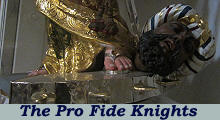
|

